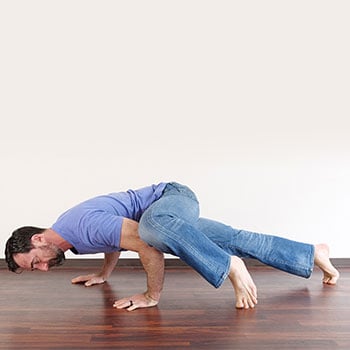Imagine a door hinge that’s been rusted over time.
It creaks, resists movement, and doesn’t function as smoothly as it once did. Similarly, our hip flexors can become “rusted” from prolonged inactivity and a limited variety of motion.
In our modern world, where sitting for extended periods is all too common, understanding and addressing tight hip flexors is essential for maintaining our health and function.
The Silent Disruptor: How Tight Hip Flexors Sneakily Impact Daily Life
 The hip flexors are like the strings of a puppet, controlling the legs’ ability to move and bend. When these “strings” are tight or restricted, the puppet’s movement becomes limited and jerky. Common culprits that affect our hip flexors include prolonged sitting and standing and similar activities that don’t allow the hip flexors to stretch and move freely.
The hip flexors are like the strings of a puppet, controlling the legs’ ability to move and bend. When these “strings” are tight or restricted, the puppet’s movement becomes limited and jerky. Common culprits that affect our hip flexors include prolonged sitting and standing and similar activities that don’t allow the hip flexors to stretch and move freely.
Makes sense, sitting in a chair for a long time every day for years can make you “chair shaped”.
Think of your body as a finely tuned orchestra. Tight hip flexors can subtly affect our daily movements, making simple tasks like backward bending or getting out of a car feel like a chore.
It’s like trying to drive with the handbrake on; you can move, but something feels off.
Tension at the hip flexors is also implicated with back pain and while it may not be the primary cause, it can certainly be a contributing factor along with all the other issues that lead to persistent back pain (stress, habitual prolonged postures, poor resilience, etc.,)
 Conversely, tight hip flexors can be also symptom of issues stemming from your back. This is because the psoas attaches from the front of the lumbar spine into the legs and can both pull on your leg to lift it up, or pull on the spine.
Conversely, tight hip flexors can be also symptom of issues stemming from your back. This is because the psoas attaches from the front of the lumbar spine into the legs and can both pull on your leg to lift it up, or pull on the spine.
The psoas muscle is like the bridge connecting two major cities: the spine and the legs. When this bridge is under tension, traffic (or movement) between the cities is affected.
Decreased low back strength and mobility can lead to compensations such as tighter hip flexors that try to help counter those stresses. That’s why it’s important to do more than isolated stretches and exercises for the hip flexors. It’s best to have a plan that integrates isolated work with full body movement.
Everything is connected.
The Elastic Dilemma: Weakness and Tightness Go Hand in Hand
 Consider the design of a suspension bridge. The strength and stability of the bridge don’t just rely on the towers or the roadway but significantly on the tension in its supporting cables. If these cables are slack or overly taut, the bridge may wobble, sway, or even collapse under pressure. Similarly, to truly address tight hip flexors and ensure they function optimally, we need a comprehensive approach. It’s not enough to merely stretch them out occasionally. We must engage in exercises that target the hips, trunk, and entire lower body, taking them through a complete range of motion.
Consider the design of a suspension bridge. The strength and stability of the bridge don’t just rely on the towers or the roadway but significantly on the tension in its supporting cables. If these cables are slack or overly taut, the bridge may wobble, sway, or even collapse under pressure. Similarly, to truly address tight hip flexors and ensure they function optimally, we need a comprehensive approach. It’s not enough to merely stretch them out occasionally. We must engage in exercises that target the hips, trunk, and entire lower body, taking them through a complete range of motion.
It’s essential to emphasize tension and strengthening work at both the shortest and longest ranges of hip flexor motion. Just as a bridge requires the right tension in its cables to support varying loads and withstand diverse conditions, our hip flexors need to be robust and resilient throughout their entire range.
This ensures that whether you’re doing something simple like bending down to pick up a heavy box or sprinting to catch the L train, your hip flexors are prepared, strong, and flexible, reducing the risk of strains and injuries.
Another helpful analogy is thinking about a rubber band. If you keep it coiled up tightly for an extended period, it starts to lose its elasticity. When you finally decide to stretch it out, it might not extend as far as it once did, or it might even snap. Our muscles, particularly the hip flexors, behave in a similar manner. When they’re constantly kept in a shortened state, such as when we’re seated for prolonged hours at our desks or on the couch, they aren’t exposed to their full range of motion.
Over time, this leads to a decrease in their flexibility and strength, especially when we try to stretch or engage them in more extended positions.
Three Essential Strategies to Combat Hip Flexor Tightness
1. Targeted Dynamic Stretching
Think of this as the morning stretch we instinctively do when we wake up. It’s not just about lengthening the muscle but doing so with movement to ensure flexibility and strength.
Traditional static stretching focuses on holding a stretch for a certain duration, aiming to lengthen a specific muscle. While beneficial, it’s just one piece of the puzzle. Dynamic stretching, on the other hand, combines the benefits of stretching with movement. It’s not just about elongating a muscle; it’s about doing so while in motion, ensuring both flexibility and strength are addressed.
 We’ve been teaching the kneeling lunge in our programs right from the start, emphasizing not just the stretch but also the dynamic movement into and out of the stretched position. A simple addition of 30 seconds of movement to 30 seconds of holding the stretch more than doubles the benefit!
We’ve been teaching the kneeling lunge in our programs right from the start, emphasizing not just the stretch but also the dynamic movement into and out of the stretched position. A simple addition of 30 seconds of movement to 30 seconds of holding the stretch more than doubles the benefit!
2. Targeted Muscle Strengthening
Your nervous system is pretty smart, and operates like an intuitive guardian, always on the lookout for your well-being. It’s finely tuned to sense potential threats and protect you from harm. Imagine trying to stretch a rubber band beyond its capacity; there’s a risk it might snap. Similarly, if your muscles aren’t conditioned to support a longer length, your nervous system intervenes. It restricts excessive stretching to prevent potential injuries. This protective mechanism ensures that you don’t overextend and damage your muscles, especially if they’re not prepared for such a range.
Often, we might perceive a tight muscle as inherently strong, “strong and tight” is a common phrase.However, this isn’t always the case. Just as a tightly wound spring can be fragile if it lacks the proper support, a muscle can be both tight and weak. This combination can leave it vulnerable to strains and injuries.

The Front Scale is another staple exercise that addresses hip flexor strength along with integrating it with balance and flexibility.
It’s deceptively complex and a great example of “you won’t know until you try it”! The combination of maintaining your posture, balancing, and maintaining the leg position challenges your hip flexors in a holistic way.
That’s why it’s not just about addressing the tightness; it’s about fortifying the muscle with strength. By concurrently working on both flexibility and strength, we ensure that our muscles are not only supple but also robust and resilient.
3. Integrated Whole Body Movement: Locomotion
By now you’ve gotten the gist that it’s not just about isolated strength or flexibility in one area; it’s about the symphony of movement that arises when every part of our body collaborates seamlessly.
It’s not merely about moving individual muscles, but about orchestrating them to work in harmony, creating a dance where each part complements the other.
Locomotion exercises exemplify this principle. When we engage in these movements, we’re not just going through the motions; we’re cultivating a deep connection between different parts of our body. It’s like teaching an orchestra to play in unison. Each muscle, joint, and ligament learns its role and how it fits into the grander scheme of movement.
 Consider the hip flexors in this integrated approach. Often overlooked or treated in isolation, they play a pivotal role in our overall movement. Through locomotion exercises, the hip flexors are dynamically engaged, stretched, and strengthened across a spectrum of positions.
Consider the hip flexors in this integrated approach. Often overlooked or treated in isolation, they play a pivotal role in our overall movement. Through locomotion exercises, the hip flexors are dynamically engaged, stretched, and strengthened across a spectrum of positions.
The Crab locomotion, one of the core movements in Elements, is a stellar example of working on the hip flexors through their lengthened range. More than a simple stretch, you work on gracefully combining movements and are challenging not just one bodypart but your entire body.
This approach does more than just enhance flexibility; it builds resilience. It ensures that our hip flexors, and by extension our entire body, are prepared for the diverse challenges of daily life. Whether it’s bending down to pick up a child, reaching up to a high shelf, or participating in a sport, our body is ready, not just because of strength in one area, but because of the collective harmony of all its parts.
An Extra Bit of Guidance
 It’s pretty common advice to take breaks when you have to sit for a long time, and it’s easier said than done sometimes. But it doesn’t make it less true. A minute here and there might not seem like it would make a big difference, but those minutes do add up throughout the day. And they definitely do disrupt your body from cementing itself into that “chair shape”.
It’s pretty common advice to take breaks when you have to sit for a long time, and it’s easier said than done sometimes. But it doesn’t make it less true. A minute here and there might not seem like it would make a big difference, but those minutes do add up throughout the day. And they definitely do disrupt your body from cementing itself into that “chair shape”.
And even better would be to incorporate what we’ve talked about above so you can squeeze out the most out of that one minute break!
Free Up Your Hip Flexors and Enjoy Your Life
Tight hip flexors can be more than just a minor inconvenience; they can significantly impact your quality of life. This tightness can lead to discomfort during everyday activities, limit your range of motion, and over time, untreated tightness can exacerbate other problems, making simple tasks like bending or walking uphill feel challenging.
By understanding the root causes of this tightness and implementing effective strategies, you not only alleviate immediate discomfort but also invest in long-term mobility and well-being. It’s about taking proactive steps today to ensure a more flexible and pain-free tomorrow.

I came to you 7 weeks ago and enrolled in the Mobility program as a 59-year-old with a hip problem. I'm now moving around like a 20-year-old! I've just enrolled for the Elements and Integral Strength programmes. Thank you GMB, for the wealth of knowledge and the work you all put in.



